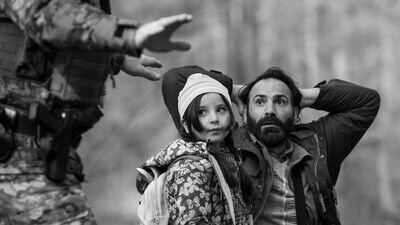The titular border is the one separating Poland from its neighbor to the east, Belarus. When we first see a portion of the border, filmed from an aerial angle, it is a spectacularly beautiful green, the evidence of one of the last remaining primeval forests in Europe. But that visual beauty doesn’t last. Soon enough, the image shifts to black and white, and we enter a human world of violent oppositions and tragic ironies.
At first, we are on an airplane crowded with individual travelers and families, some dozing as others babble in excited anticipation of their expected goal: safety, freedom. They are refugees from places in the decimated east, such as Syria and Afghanistan. When the plane lands, the passengers spill out of the terminal and begin shouting into cell phones to distant relatives trying to help. A van arrives, people pile in. Kids in the group talk happily about how they’ll soon – hours from now? – be in Sweden. Adults caution that they must first enter the nearest European Union country, which happens to be Poland.
The border turns out to be a dense forest bisected by a wall of wire and barbed wire. When the passengers are dumped unceremoniously in this remote locale, they soon see that they are pawns in a deadly geopolitical game. Polish soldiers meet them only to push them back across the wire wall. There, Belarusians harshly eject them back into Poland. It is like a horrible, endless ping-pong game; one played for the highest stakes.
Though it has received precious little media attention in the West, the crisis dramatized here is very real. It began in late 2021 when Aleksandr G. Lukashenko, Belarus’s Putin-allied, autocratic president, started offering free transit visas and transportation to people in the Middle East and Africa who wanted to reach Europe. His apparent aim was to inject a degree of destabilization into EU countries that were disinclined to accept an influx of refugees from distant, alien countries. (Holland points out the racial/cultural dimensions of this resistance by noting that, only a year later, Poland generously opened its borders to two million refugees from neighboring Ukraine.)
Surely, cinema has a unique potency in conveying the human realities of a situation like this, where a group of strangers are trapped in a terrible, nightmarish, steadily worsening situation. Here, politics are a distant abstraction. The only realities are the refugees’ desperation, confusion, disorientation, and stubborn determination even in the face of the brutality visited on them; Holland crafts vivid, compelling portraits of these unfortunates – including three generations of a Muslim family led by a crusty patriarch (Mohamad Al Rashi) who refuses to let danger separate him from his prayer rug – while skillfully avoiding the melodramatic cliches such a premise invites.

